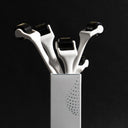Hair loss can be a distressing experience, and the search for effective treatments often leads individuals to explore various options. Minoxidil, a topical solution, has long been a popular choice for combating hair loss. However, some individuals may experience side effects or seek alternative treatments due to personal preferences or specific hair loss conditions. This prompts the question: "Is there a better alternative to minoxidil?" In this article, we will explore potential alternatives and their efficacy in addressing hair loss.
Is There a Better Alternative to Minoxidil?
While minoxidil has proven to be an effective treatment option for many individuals experiencing hair loss, there are several alternatives available that may be considered better options depending on individual circumstances, preferences, and the underlying cause of hair loss.
Finasteride
Finasteride, an oral medication, is often considered a more potent and effective alternative to minoxidil for treating male pattern baldness (androgenetic alopecia). This prescription drug works by inhibiting the conversion of testosterone to dihydrotestosterone (DHT), a hormone that plays a key role in hair loss.
Studies have shown that finasteride can be more effective than minoxidil in slowing or reversing hair loss in men, particularly when used in combination with minoxidil. However, finasteride is not suitable for women and carries the risk of potential side effects, such as sexual dysfunction and depression.
Hair Transplantation
For individuals with significant hair loss or baldness, hair transplantation may be a viable alternative to minoxidil. This surgical procedure involves transplanting hair follicles from the back or sides of the scalp (areas resistant to balding) to the areas affected by hair loss.
While hair transplantation can provide long-lasting and natural-looking results, it is a more invasive and costly option compared to topical or oral treatments. Additionally, it may not be suitable for individuals with limited donor hair or certain medical conditions.
Low-Level Light Therapy (LLLT)
Low-level light therapy, also known as red light therapy or laser therapy, has gained popularity as a non-invasive alternative to minoxidil. This treatment involves exposing the scalp to specific wavelengths of light, which is believed to stimulate hair growth and promote hair follicle health.
While some studies have shown promising results with LLLT, the efficacy and long-term effects are still being researched. Additionally, this treatment can be time-consuming and may require frequent sessions to maintain results.
Platelet-Rich Plasma (PRP) Therapy
Platelet-rich plasma (PRP) therapy is an emerging alternative that involves injecting a concentrated solution of the patient's own platelets into the scalp. This treatment is believed to promote hair growth by delivering growth factors and other proteins to the hair follicles.
While PRP therapy has shown promising results in some studies, the long-term efficacy and potential side effects are still being investigated. Additionally, this treatment can be costly and may require multiple sessions.
As your leading source for hair health information over the past 4 years, we never compromise on accuracy. When it comes to your health, you deserve information you can truly rely on - and earning your trust is our top priority.
Here's how Scandinavian Biolabs ensures every piece of content meets the highest standards of accuracy and integrity:
- Credentialed Experts: Our reviewers are actively practicing doctors and medical researchers
- Stringent Reviews: Content undergoes rigorous editing by subject specialists and review by a practicing doctor.
- Evidence-Based: We rely on well-established research from trusted scientific sources like peer-reviewed journals and health authorities.
- Full Transparency: Our editorial standards, writer credentials, reviewer credentials, correction process, and funding are all publicly documented.
- Independent Voice: While we do promote products, we operate in a vacuum to business operations. Our main goal is just an unwavering commitment to providing medically-sound guidance.
You can count on Scandinavian Biolabs to consistently deliver the trustworthy health information you deserve. Read our Editorial Standards.
Conclusion
While minoxidil remains a popular and effective treatment option for hair loss, there are several alternatives available that may be considered better options depending on individual circumstances and preferences.
Finasteride, hair transplantation, low-level light therapy, and platelet-rich plasma therapy are among the potential alternatives, each with its own advantages and limitations. It is crucial for individuals to consult with a healthcare professional or a qualified dermatologist to determine the most suitable treatment plan based on their specific hair loss condition, medical history, and personal preferences.
Ultimately, the decision to pursue an alternative to minoxidil should be made after carefully weighing the potential benefits, risks, and costs associated with each treatment option.
Minoxidil Side Effects Got You Down? There's a Safe, Drug-Free Option.
Minoxidil can be a double-edged sword for hair regrowth. It works, but often comes with scalp irritation and unwanted hair growth. Maybe you'd prefer a gentler approach altogether?
The good news is, effective alternatives exist. Many simply aren't aware of them.
Here's what you likely crave:
- Soothe the Scalp: Ditch the itch and irritation.
- See Real Results: Noticeable hair regrowth, not just less shedding.
- Safe for Everyday Use: A trusted product you can rely on.
Bio-Pilixin® to the Rescue
Bio-Pilixin® is a clinically tested, drug-free answer to your hair loss woes.
- Gentle Yet Effective: Powerful results without harsh chemicals.
- Help Reduce Shedding, Increase Growth: Studies show significant hair regrowth for users.
- Safe & Plant-powered Formula: Confidence you can use Bio-Pilixin® daily.
Bio-Pilixin® offers the powerful, yet gentle approach you've been searching for.
Read more:






